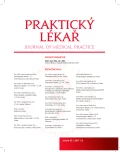Inoperable form of alveolar echinococcosis of the liver
Authors:
R. Rosoľanka 1
; Peter Lipták 2
; Ľ. Laca 3; M. Hošala 3
Authors‘ workplace:
Jesseniová lekárska fakulta v Martine Univerzity Komenského v Bratislave
Dekan: prof. MUDr. Ján Danko, CSc.
; Klinika infektológie a cestovnej medicíny
Prednostka: doc. MUDr. Katarína Šimeková, PhD.
1; Interná klinika – gastroenterologická
Prednosta: prof. MUDr. Rudolf Hyrdel, CSc.
2; Chirurgická klinika a transplantačné centrum
Prednosta: prof. MUDr. Ľudovít Laca, PhD
3
Published in:
Prakt. Lék. 2017; 97(6): 280-282
Category:
Case Report
Overview
Echinococcosis is considered dangerous animal-derived parasitosis (helmitozoonosis). Cystic echinococcosis (CE) and alveolar echinococcosis (AE), also known as alveococcosis, are among the most important. AE is considered to be a rare disease and predominantly affects the liver in 90–95% of cases. The incidence of this severe helminthozoonosis is increasing in Central Europe. We present the case of a 50-year-old female patient without significant past medical history. She complained about intermittent dyspeptic symptoms such as loss of appetite and repeated vomiting-associated abdominal pain. The diagnosis alveolar echinococcosis was made based on positive epidemiological history and typical CT liver imaging. It was evaluated as an inoperable stage of disease and therefore a conservative therapy with albendazole has been initiated. The patient's status has been monitored regularly during follow up period. Accepted duration of conservative treatment is 2 years after radical surgery or even life long in situations where radical surgery is not possible.
Keywords:
alveolar echinococcosis – echinococcus multilocularis – inoperable form
Sources
1. Šimeková K, Szilágyiová M, Antolová D, et al. Contribution to the diagnosis and treatment of life-threatening parasitosis caused by the parasite Echinococcus multilocularis. Vector Borne Zoonotic Dis 2017; 17(4): 225–228.
2. Rosoľanka R, Antolová D, Nováková E, a kol. Závažné život ohrozujúce parazitárne ochorenie komplikované disemináciou do pľúc. Gastroent Hepatol 2016; 70(2): 145–149.
3. Vuitton D, Bresson-Hadni S. Alveolar echinococcosis: evaluation of therapeutic strategies. Expert Opin Orphan Drugs 2014; 2(1): 67–86.
4. Kinčeková J, Dubinský P, Dvorožňáková E, a kol. Diagnostika a výskyt alveolárnej echinokokózy na Slovensku. Čes. Slov. Gastroent. Hepatol. 2005; 59(1): 11–16.
5. Švihrová V, Szilágyiová M, Krkoška D, et al. Analysis of the direct and indirect costs of treatment of imported malaria in the Slovak republic. Rev Soc Bras Med Trop 2009; 42(4): 377–380.
6. Rosoľanka R, Nováková E. Larva migrans cutanea – importovaná kožná nákaza a možnosti jej liečby. Prakt. Lék. 2016; 96(3): 141–143.
7. Szilágyiová M, Michal L, Šimeková K, a kol. Poškodenie pečene pri niektorých infekčných ochoreniach. Klin mikrobiol inf lék 1998; 4(10): 299–301.
8. Šimeková K, Viechová J. Vírusová hepatitída D importovaná do ČR občanom Moldavskej republiky. Klin mikrobiol inf lék 2005; 11(6): 226–228.
9. Roming T, Bilger B, Dinkel A, et al. Echinococcus multilocularis in animal hosts: new data from western Europe. Helmithologia 1999; 36(3): 185–191.
10. Antolová D, Miterpáková M, Škútová M, a kol. Echinococcus multilocularis na Slovensku – aktuálna situácia. INFOVET 2014; 20(6): 245–249.
11. Miterpáková M, Dubinský P, Reiterová K, et al. Climate and environmental factors influencing Echinococcus multilocularis occurrence in the Slovak Republic. Ann Agric Environ Med 2006; 13 : 235–242.
12. Miterpáková M, Dubinský P. Fox tapeworm (Echinococcus multilocularis) in Slovakia – summarizing the long-term monitoring. Helminthologia 48(3): 2011; 155–161.
13. Kern P, Bardonett K, Renner E, et al. European echinococcosis registry: human alveolar echinococcosis, Europe, 1982–2000. Emerg Infect Dis 2003; 9(3): 343–349.
14. Bresson-Hadni S, Delabrousse E, Blagosklonov O, et al. Imaging aspects and non-surgical interventional treatment in human alveolar echinococcosis. Parasitol Int 2006; 55(Suppl): 267–272.
15. Eckhert J, Schantz PM, Gasser RB, et al. Geographic distribution and prevalence. In: Eckert J, Gemmell MA, Meslin F-X, Pawlowski ZS. (ed.) WHO/OIE manual on echinococcosis in humans and animals: a public health problem of global concern. Paris, France: World Organisation for Animal Health 2001; 100–142.
16. Carmena D, Benito A, Eraso E. Antigens for the immunodiagnosis of Echinococcus granulosus infection: an update. Acta Trop 2006; 98 : 74–86.
17. Kern P. Clinical features and treatment of alveolar echinococcosis. Curr Opin Infect Dis 2010; 23(5): 505–512.
Labels
General practitioner for children and adolescents General practitioner for adultsArticle was published in
General Practitioner

2017 Issue 6
- Metamizole at a Glance and in Practice – Effective Non-Opioid Analgesic for All Ages
- Hope Awakens with Early Diagnosis of Parkinson's Disease Based on Skin Odor
- Metamizole vs. Tramadol in Postoperative Analgesia
- Advances in the Treatment of Myasthenia Gravis on the Horizon
- Metamizole in perioperative treatment in children under 14 years – results of a questionnaire survey from practice
Most read in this issue
- Follow-up and long-term care in the Czech Republic – an overview of the current state and changes in bed capacity from the National Health Information System
- Inoperable form of alveolar echinococcosis of the liver
- Dilaceration of eye caused by a fire cracker explosion
- Study of new anticoagulants – partial results
